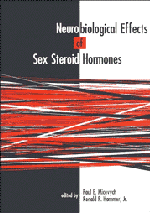Book contents
- Frontmatter
- Contents
- List of contributors
- Dedication
- Preface
- Acknowledgments
- Part I Sex steroid–responsive circuits regulating male and female reproductive behaviors
- Part II Sex steroid interactions with specific neurochemical circuits
- Part III Cellular and molecular mechanisms regulated by sex steroids
- 12 Neurosteroids and neuroactive steroids
- 13 Estrogen synthesis and secretion by the songbird brain
- 14 Neurobiological regulation of hormonal response by progestin and estrogen receptors
- 15 Molecular actions of steroid hormones and their possible relations to reproductive behaviors
- 16 Effects of sex steroids on the central nervous system detected by the study of Fos protein expression
- 17 Developmental interactions of estrogens with neurotrophins and their receptors
- 18 Sex steroid influences on cell–cell interactions in the magnocellular hypothalamoneurohypophyseal system
- Index
18 - Sex steroid influences on cell–cell interactions in the magnocellular hypothalamoneurohypophyseal system
Published online by Cambridge University Press: 15 October 2009
- Frontmatter
- Contents
- List of contributors
- Dedication
- Preface
- Acknowledgments
- Part I Sex steroid–responsive circuits regulating male and female reproductive behaviors
- Part II Sex steroid interactions with specific neurochemical circuits
- Part III Cellular and molecular mechanisms regulated by sex steroids
- 12 Neurosteroids and neuroactive steroids
- 13 Estrogen synthesis and secretion by the songbird brain
- 14 Neurobiological regulation of hormonal response by progestin and estrogen receptors
- 15 Molecular actions of steroid hormones and their possible relations to reproductive behaviors
- 16 Effects of sex steroids on the central nervous system detected by the study of Fos protein expression
- 17 Developmental interactions of estrogens with neurotrophins and their receptors
- 18 Sex steroid influences on cell–cell interactions in the magnocellular hypothalamoneurohypophyseal system
- Index
Summary
Introduction
It should not have been surprising that gonadal steroids exert powerful influences on cell–cell interactions in the magnocellular hypothalamoneurohypophyseal system (HNS) of the rat, but somehow it was. Since this system is responsible for the manufacture and release of oxytocin during parturition and lactation, times when the levels of circulating gonadal steroids show dramatic variations, some steroid involvement in the functioning of HNS could have been anticipated. Perhaps such anticipation was dulled by the observation that the dynamic interactions taking place among the cells of the HNS also occurred in response to manipulations of the animal's hydrational state, which have not been associated traditionally with variations in gonadal steroid output. However, gonadal steroids appear to exert some control over the cellular mechanisms that release both oxytocin and vasopressin in response to dehydration. Estrogens and androgens, under comparable conditions, often have opposite effects on the HNS. This chapter reviews the main structure–function relationships of the HNS, the dynamics of these relationships under physiological conditions of altered peptide hormone demand, and some of the roles possibly played in these functions by gonadal steroids in both males and females.
The magnocellular HNS
The magnocellular HNS is constituted chiefly by the supraoptic (SON) and paraventricular (PVN) nuclei, accessory nuclei in the anterior hypothalamus, and the neurohypophysis or neural lobe (NL) of the posterior pituitary to which the neurons of those hypothalamic nuclei send axonal projections (Fig. 18.1).
- Type
- Chapter
- Information
- Neurobiological Effects of Sex Steroid Hormones , pp. 412 - 432Publisher: Cambridge University PressPrint publication year: 1995



